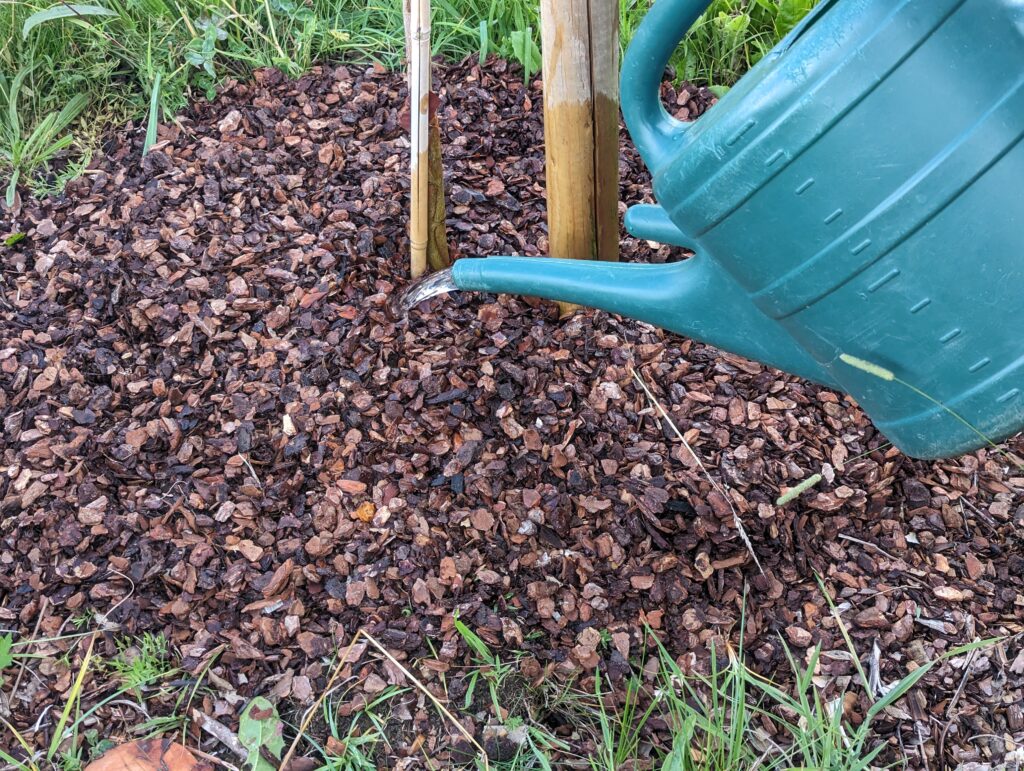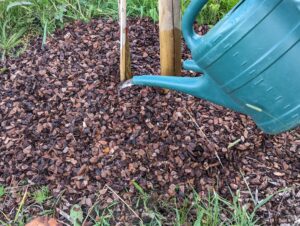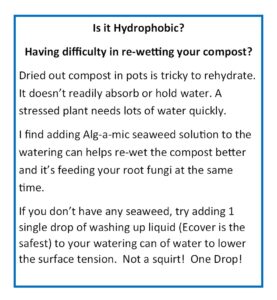
Watering is a skill. I’d go so far as to say it is an artform. For some it is intuitive, but for most people it needs taught correctly and practised. Its one of life’s compulsory, essential skills. Clean your teeth, tie your shoelaces, water your plants correctly!
In conversation with a fellow horticulturist recently, I found out that Hilliers ran an intensive whole day course on training their apprentice-growers on how to water correctly; so important was it to the survival of their nursery plants. This included all aspects of watering and even covered a range of brass roses to go on to the end of the hose-pipe-lance and how to use each one; whether it was a fine spray for seedlings or a coarse one for drenching mature stock.
Watering is the most important job in the nursery and in my view that extends also to the garden, arboretum and parkland. It’s a perennial topic of discussion at Hardy Eucalyptus HQ, every morning. A gardener can pot beautifully, weed for England and mulch till the cows come home, but it’s all a waste of time if all they do is waft a hosepipe around in the air, sprinkling the soil without any thought to VOLUME. In fact, it does more harm than good!
and
Sorry – I’ve gone into rant mode but this is a subject close to my heart!
For plants in the ground:
It’s not going to end well ☹
If the soil is lightly dampened only to a depth of a centimetre or two, the fine root-hairs (moisture seeking roots) rise to the surface looking for water instead of growing downwards chasing a water deluge of 15 litres – see later. Inadequate watering trains the roots to behave incorrectly. They should be 300 mm below ground level, not in the top 25 mm. Then, when there is insufficient water in the top layer of soil, the plant becomes dehydrated in the first instance, but further to that, the roots get cooked on hot days and frozen in winter. This shallow rooting also makes for an unstable plant; one more prone to blowing over in windy weather.
The hot drying winds and the scorching summers of late have seen us ramp up our watering programme to 3 times a day in the Hardy Eucalyptus nursery, just to keep on top of things. In your garden, hot wind strips moisture from leaves in a matter of minutes and tiny root systems cannot cope. Leaves become limp and as the water is not replaced from the ground, they go pale, then brown and crispy. Not a good look!
Eucalyptus roots can grow at the rate of 1 cm per day. We know this because we’ve measured it. If they don’t receive sufficient water during the establishment phase in your garden, they are going to die.
Once established with a good root system, Eucalyptus are very drought tolerant. But for their first growing season or two, they are entirely, utterly and completely reliant on you; their support crew. Please don’t let your Eucalypt down!
*Note from point 3 above: Tree roots don’t observe fence boundaries. Generally speaking, the extent of a root system of any species of mature tree has been found to be at least equivalent to the height of the tree itself and quite shallow; at less than 2m soil depth. In poor quality, infertile or compacted soils, roots can extend as far as x3 the height of the tree(1). The roots furthest from the tree are also very shallow, where they can absorb nutrients and rainfall from the topsoil layer
Reference(1): Tree Root Systems by Martin Dobson of the Tree Advice Trust 130/95/ARB Arboricultural Advisory and Information Service July 1995
http://www.trees.org.uk/Trees.org.uk/files/61/6181f2b7-e35d-4075-832f-5e230d16aa9e.pdf

I know – it’s boring to watch! But on average, that is how much water you need to be giving your trees – around 3 gallons (15 L).
You need to know exactly how many litres of water you are giving to your new trees. Wetting the soil surface for 30 seconds or leaving a hosepipe running for an unspecified amount of time simply doesn’t cut it.
Follow our watering chart in these guidance notes and measure the amount of water you give to your trees.
YEAR 1 watering – choose your original pot size from when you purchased your tree

March April & May: water well unless rainfall is torrential for a whole day and the ground is saturated. March 2023 was the driest since records began and so watering would have been vital.
June to September: this is when Eucs do nearly ALL of their growing for the year. They go completely bonkers in August, so ensure maximum watering. Ease off watering a little if it’s a wet September.
We recommend a drip or leaky pipe irrigation system for pot sizes of 30 – 100 litre. Set the system to deliver water to the outside edge of the original root ball i.e. to deliver into the zone where the new roots are growing
October to February (Winter): cold dry winds strip moisture from evergreen foliage, so do water under cold, dry conditions. More young Eucalyptus die from drought than cold in the winter months. You won’t need to water over the winter if it’s very wet or snowing.
If it’s not practical to water large scale plantings after year 1, first-class care will be required in year 1 to ensure good establishment quickly.
What’s your soil type? Watering during year 2 will be necessary when there is little or no rainfall for several weeks over the summer and also on sites which receive little annual rainfall such as drier easterly counties, and those with sandy or free-draining soils.
Year 2
March, April and May: no watering required unless there is a freak drought
June, July, August and September: half of year 1 rations
October to February: no watering required. Your tree should now have established well and be independent of your ministrations, but keep an eye on it in dry windy conditions.
For plants in pots – especially air-pot containers:
Plants in pots are more at risk of failure through lack of water than those in the ground. Their small world of containerised roots can change from blissfully hydrated to stressed in a matter of minutes, followed quickly by ‘brown and crispy’.
Lightly dampening the surface of a pot grown plant also results in shallow rootedness of the plant as detailed above. In a container scenario, we water from the top down, but very often the compost dries from the bottom up and this can lead to a complete imbalance of moisture throughout the pot. A potted plant is quickly stressed in a matter of hours on hot sunny days, when not given enough water and the foliage can quickly turn brown and crispy, especially if there is an accompanying breeze. Insufficient water leads to a desiccated plant and poor root development.
Q: How do you know when a container plant has received sufficient water?
A: (i) If it is a pot of 400mm diameter or less and you can lift it, pick it up and see if it feels really, really heavy – like wrist-breaking heavy! If not – you will need to plunge it or use a wetting agent – see below.
(ii) If it isn’t mulched with slate or bark and the compost is on view, it should turn from milk chocolate colour to dark chocolate colour. Dark chocolate is better for you and your tree!
(iii) Water should pool out of the bottom of the pot, but this is tricky if the compost is really dry already, because the water will just race through it and not rehydrate on the way down. In this case the pot will be very light in spite of your watering. This means you will need to use a wetting-agent. See the notes below

Air-pots are quite challenging to water by hand. You cannot rush the process. It requires 3-4 goes of dribbling to get the water to be accepted by the compost and taken down into the pot.
The watering rule is much, more simple from April until October
From November to April, follow our winter protocol for pot grown Eucs; more on that one in a future blog post.
At Hardy Eucalyptus we have minimised hand watering and installed as much drip irrigation as we can. The latter is only as good as the people monitoring it, checking nozzles, delivery rates against wind speed and sunshine and observing plant health. Crop walking has replaced hand watering. Intensive hand watering is reserved for the plant propagation units where close scrutiny is required several times a day.
Q: Is it possible to over-water a Eucalyptus either in the ground or in a pot?
A: It is possible to overwater in the ground if you are not paying attention to monsoon-like rainfall, soil moisture and the volume of water you are giving to your tree. You certainly dont want to see your tree sitting in a pond! Sometimes its worth digging a little hole alongside the tree to investigate soil moisture levels at 6 inches down. Its all about being intuitive.
With a containerised Eucalyptus, especially in an air-pot container (which it should be) – within reason, it’s not possible to overwater it, provided it is not being kept in a solid ornamental container as the pot cover. See our Guidance Notes on Growing in Containers. The pot cover needs to have at least one hole in the bottom, through which excess water can escape. Whilst it loves water over the summer months, your tree is not aquatic! It does not want to sit soaking in a solid trug of water for more that an hour, after which it will need time to drain. Its important to realise that soaking in trugs of water too frequently can result in all the plant food held in the compost being dissolved and flushed away! Your tree is then at risk of starving to death! Nobody said gardening was easy, but it can be fun! 😁
However, correctly irrigating your new Euc without following the other guidelines for establishing a Eucalyptus will not let you off the hook. These are the rules of the tree btw, not ours. We have done the research so you don’t have to!
We ran a trial at Hardy Eucalyptus. We deliberately grassed around a E. Azura for several months in the summer and administered leaky hose irrigation twice a day on a timer, come rain or shine. Its ‘friends’ had no grass and some had a bark chip mulch. None of the trees died in the trial. All of them grew several feet over the 3 month period except the E. Azura, which didn’t grow at all – not 1 cm. At the end of the 3-month period, we removed the grass and replaced it with 900mm diameter woodchip mulch. The E. Azura grew 2cm on every shoot tip within 2 weeks after being released from its grassy collar.
So there you have it. Watering correctly requires quite a bit of mental as well as physical effort – it’s an art. There is no quick fix and there ain’t an app. However, once you are in tune with what your plants truly need, hand-watering can be quite a relaxing, therapeutic past time.
Happy irrigating!